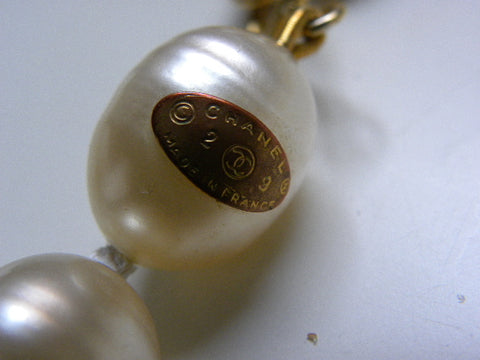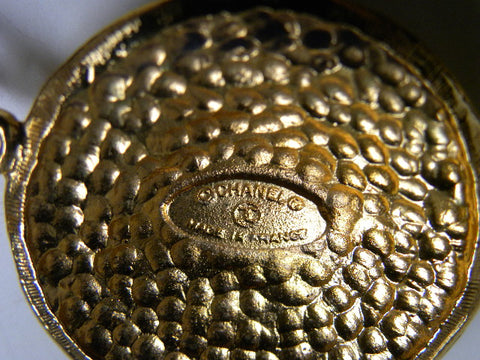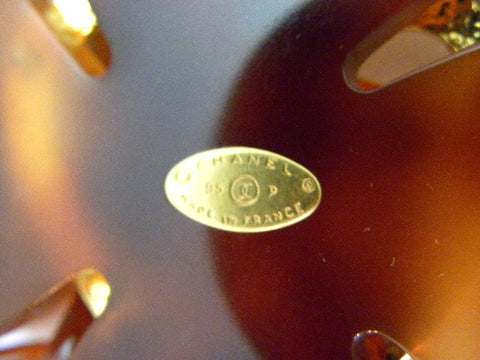The Ultimate Guide to Dating Chanel Jewellery
I have been asked many times to advise on how to spot fake Chanel jewellery, especially now that it is so popular and expensive. The obvious reply is to handle as much vintage Chanel as you can - but this is not exactly practical for most people! If you know Chanel well it is easier to spot a fake - the weight must feel substantial, the workmanship is of the highest class, and the signature must be authentic (see below). If you pick up a piece of Chanel vintage jewellery it must not feel light or tinny, I was once shown a supposed Chanel necklace that seemed to have all the correct markings but it felt very light and when the charms knocked together it sounded like a cheap wind chime! Something else to look for is obvious soldering marks. No workmanship should be visible on a genuine vintage Chanel piece. Hangtags are another giveaway. Genuine hangtags are very thin and slightly elongated, while fake ones are often fatter and slightly more rounded. Here is a genuine hang tag:
Markings
Since the 1920's, the House of Chanel has been producing some of the highest quality costume jewellery in the world, utilising the skills of some of the most famous and accomplished jewelers, including Augustine Gripoix, the Duke of Verdura, Robert Goossens, and Victoire de Castellane. Indeed, it was Chanel who introduced the whole concept of costume jewellery, larger than life pieces that deliberately played on the fact that the materials were not precious.
Initially, Coco Chanel produced her jewellery to compliment her outfits, so they were not regarded as stand-alone pieces, but as part of the whole ensemble. None of these pieces were signed, and it goes without saying that these early pieces are extremely rare and require considerable expertise to authenticate them.
Chanel closed her Rue Cambon shop during the Second World War, only opening it again in 1954. It was after this that her jewellery began to be signed, and in reference books such pieces are usually dated 1954-1971 (from the date of the first known signature to Chanel's death in 1971). The signature at this time was simple, 'CHANEL' was stamped either directly onto the piece, or was attached via a hangtag, as shown above. There was one small variation, for the Haute Couture pieces, and therefore those of the highest standard, three stars were also included immediately below the 'CHANEL.' It was also during this period that Chanel's collaboration with Robert Goosens began.

1970's
With Chanel's death came a new owner who recognised the commercial importance of the Chanel name, and therefore began to use the trademark signs on all the jewellery they produced. His name was Alain Wertheimer and he introduced the copyright and registration marks to protect the Chanel name. A signature plaque was added that featured 'CHANEL' bracketed by the copyright and registration marks. For the first time the CC logo was added, together with 'MADE IN FRANCE.'
1981 - 1985
Until this point, no dates had been used on the signature plaques, but in 1981 the date began to be added as a four digit number on the bottom of the plaque. The plaque itself was usually an oval or round hangtag, or it was attached directly onto the piece. In rare cases the hangtag is hexagonal. It is similar to the previous plaque, except for the fact that the year now appears at the bottom, and the 'Made in France' has disappeared.
This is the period during which Karl Largerfeld was appoint as head designer (1983) and he sought consciously to evoke the style and quality of Chanel's iconic designs, while giving them a modern aesthetic. The following year he appointed Victoire de Castallane to head up jewellery design, and she produced most of the famous Chanel pieces that are so collectable and continue to inspire today. She was employed from 1984 until 1998, an amazingly creative period. De Castellane introduced a new dating system when she arrived, moving from a specific year to the idea of a Season. She began with Season 23, and ended with Season 29, which roughly correspond to the years 1984-1996, for example 1990/91 equates to Season 26. This dating system ran in conjunction with the year/collection described below. The catwalk pieces tended to be given the Season/number.

This First image shows that sometimes the signature plaque was attached directly to one of the pearls rather than added as a hangtag.
1990 - 1991
The dating system changed yet again in 1990. The plaque lost all reference to date, and simply shows 'CHANEL' along the top of the plaque, the CC symbol at the centre, and 'MADE IN FRANCE' BELOW. Pieces bearing this tag were produced for Season 1990/91.
1993 Onwards
In 1993, the dating system changed again, and it is largely the system that they still use today, with a few minor variations. From this date, Chanel introduced two annual collections to coincide with the couture catwalk shows, one in Spring, and the other in Autumn. As well as designating the Season, the year was added and denoted by the final two digits. For example, 95 indicates 1995. The copyright and registration marks return around the 'CHANEL,' as well as 'MADE IN FRANCE' along the bottom. On either side of the CC logo are the the two digit date and the one letter Season (P for Spring/Printemps, A for Autumn/Automne). The plaque is usually attached directly to the item of jewellery, or appears in the form of an oval hangtag.
After 1998, with the departure of Victoria de Castellane, some new elements have been introduced, such as the annual Cruise collection, denoted by a C instead of an A or P. Rings have also been added to the range, and some pieces are now made in Italy instead of France. In addition to this, the lovely spring ring clasps are being replaced with the less aesthetically pleasing lobster clasps. Many collectors agree that the jewellery produced after this date has lost much of the artistry, chic and glamour of the Chanel years.







